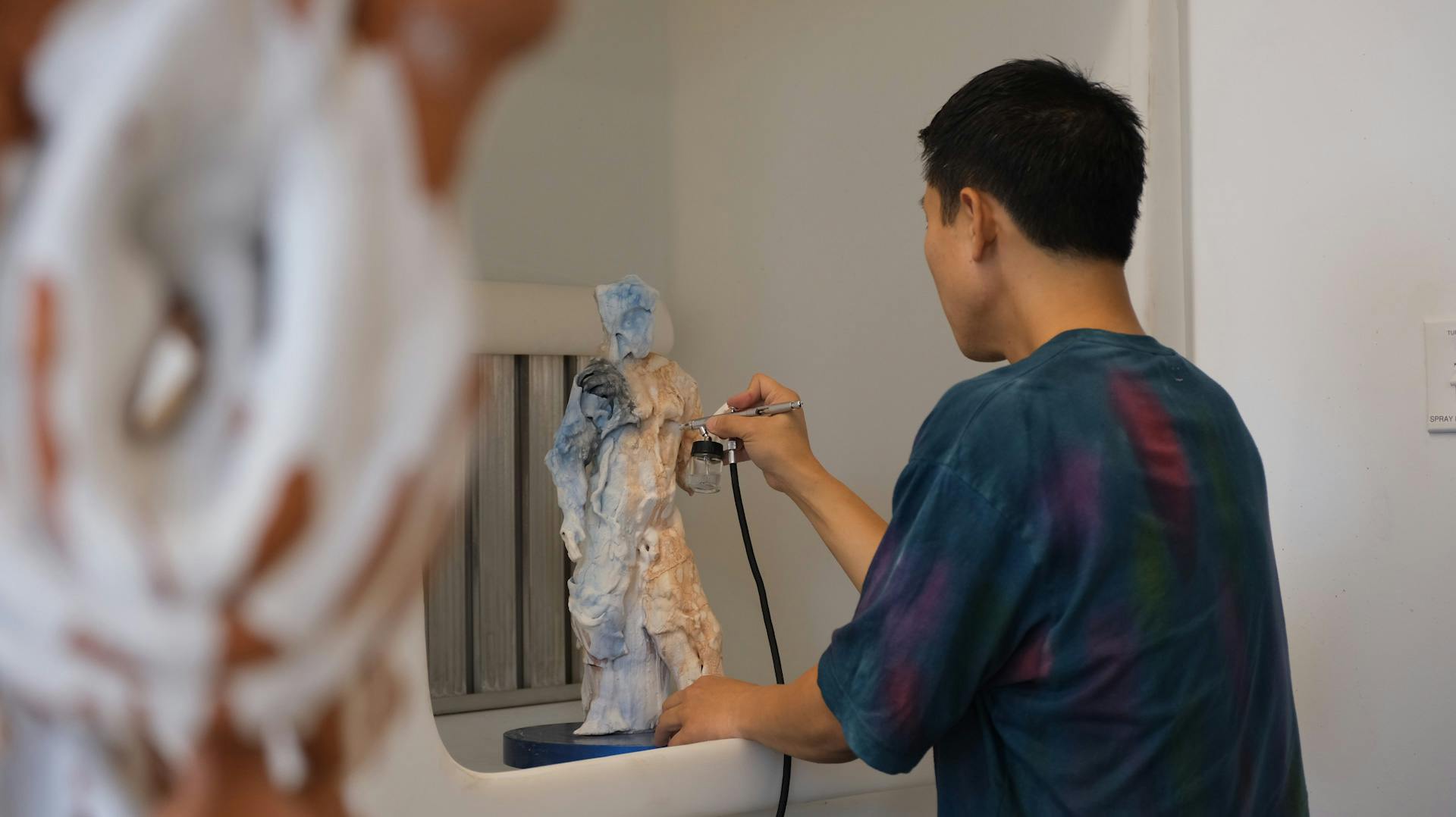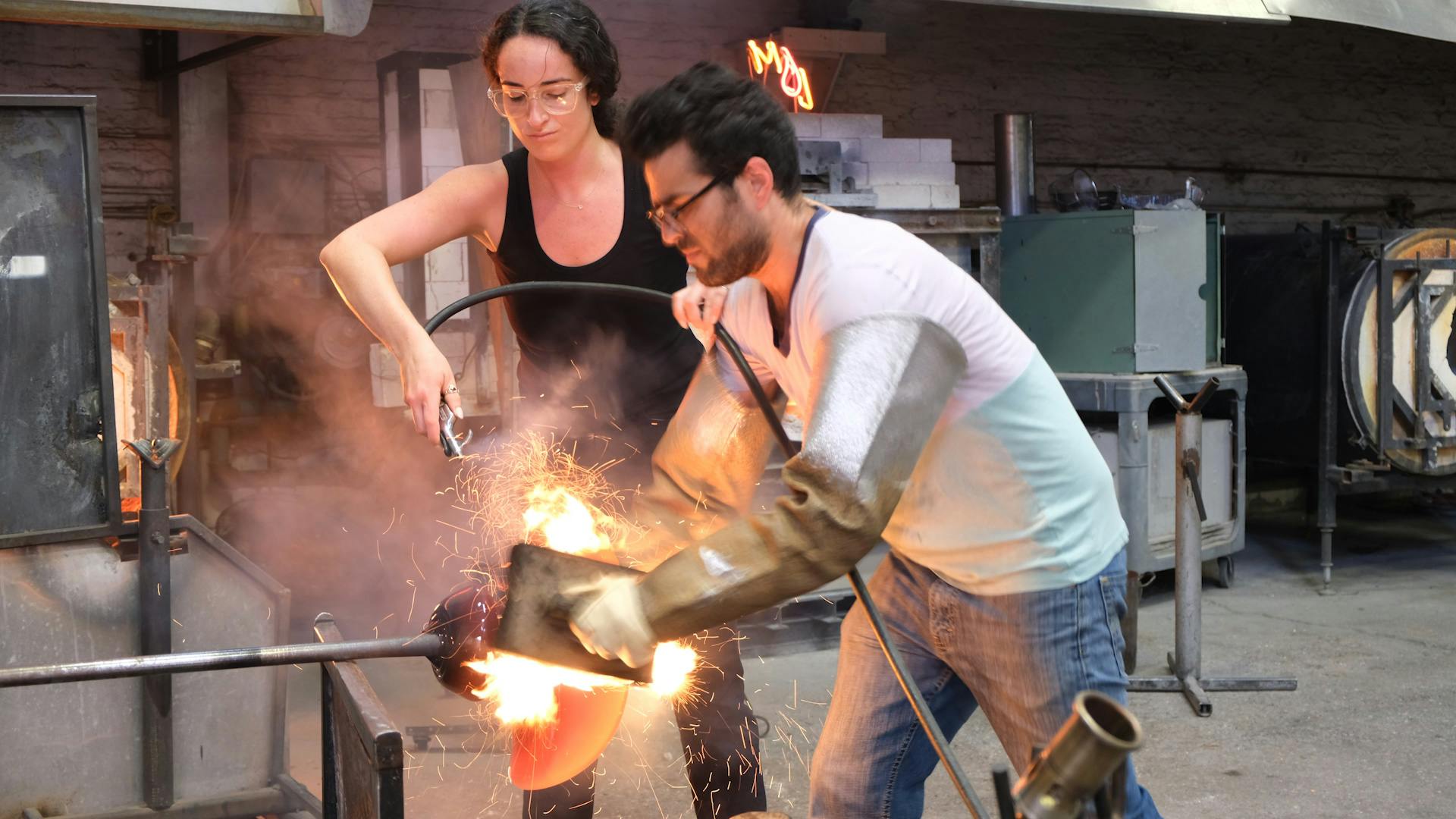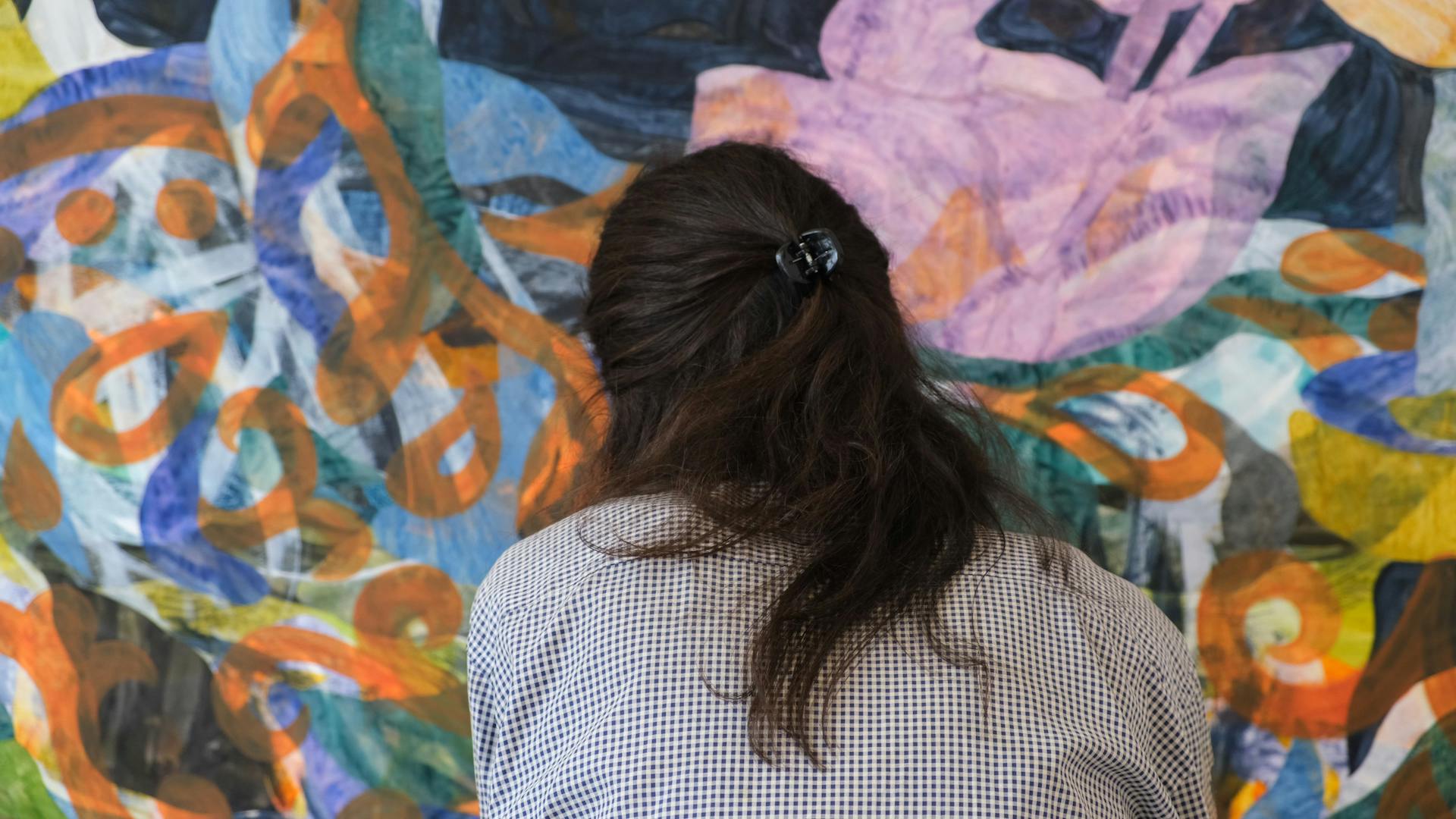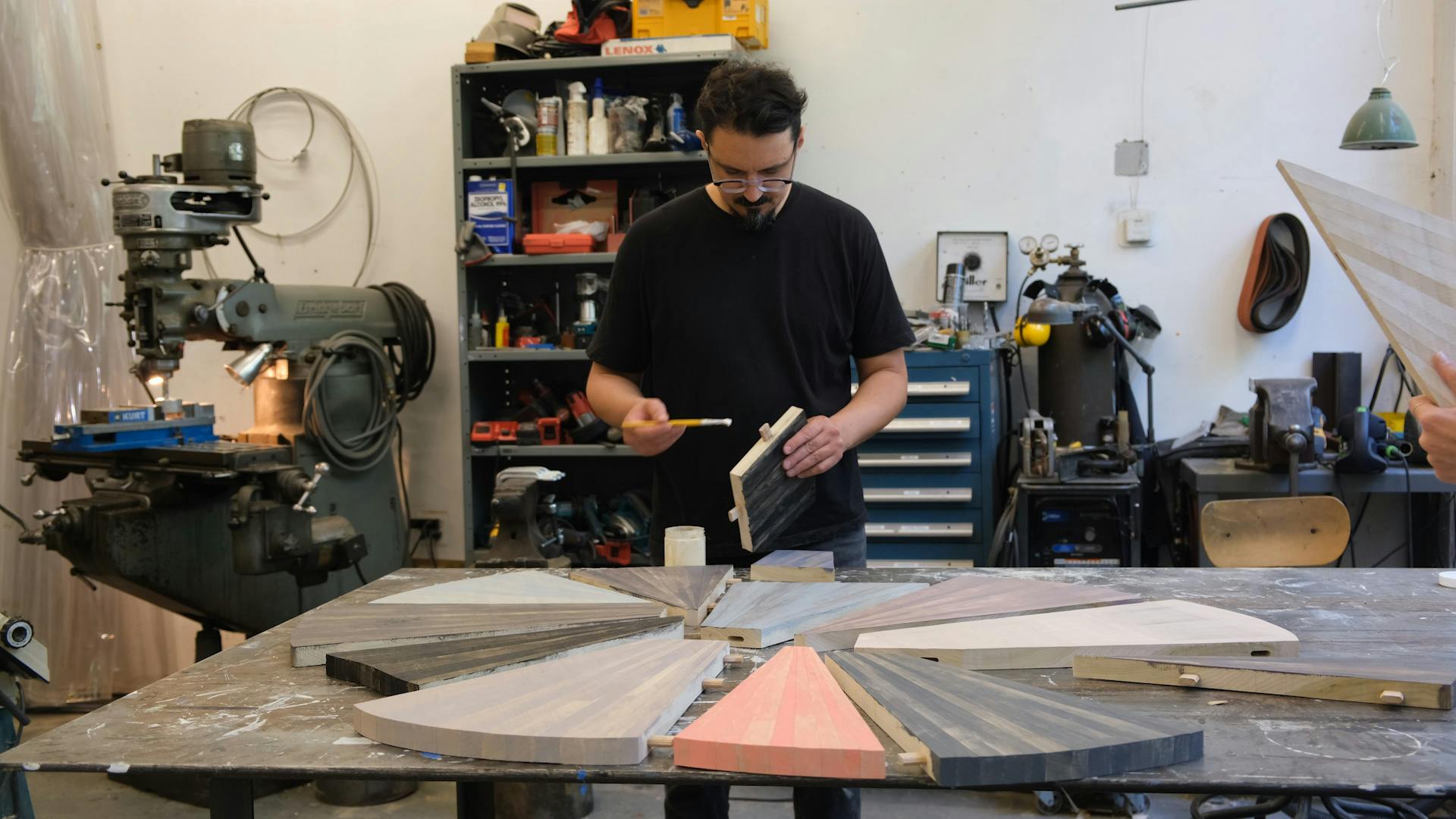Published October 21, 2022
Connecting with Artists
As the Content Lead at Testudo, Kate Parvenski produces our Studio Spotlight video series, offering up a behind-the-scenes look at our artists’ work and their practices. From filming glass-blowing to painting, and ceramics to large-scale installations, Kate’s camera has taken us to the studios of over 10 artists and counting. After a summer of visits, we asked Kate for some tips on connecting with artists in their studios.
Part of my role at Testudo involves visiting our artists’ studios to capture their process in person. Having such an up close look at an artist’s work and practice feels like a special privilege, but you don’t necessarily need to be interviewing an artist to have this kind of experience. In our increasingly digital world, most artists are all too familiar with sharing and promoting their work to audiences on social media and in person. Some artists will jump at the opportunity to discuss their practice, while others are a bit more reserved and prefer to let the work do the talking. No matter the context, here are a few tips for connecting with an artist you admire:
Start with your own research
Being in an artist’s studio can be a sensory overload, so it’s helpful to have some background knowledge of the artist and their work before the visit. I’ll research as much as I can about an artist with a quick Google search - looking at an artist’s website, social media accounts, and any other written or video interviews I can find. Other written texts, like graduate theses, can also be helpful to learn more about the context for a body of work.
Before the visit, I jot down at least 10 questions I’m going to ask the artist on a notecard. Even if I don’t look at the notecard during the interview, this helps me orient myself and organize my approach to the artist and their work. I’m also managing camera and sound equipment, so having pre-planned questions is extremely helpful to my own process. Essentially, I want to be as prepared as possible when I’m entering a person’s studio.
Be mindful
As with any new connection, it’s important to be respectful of a person’s time and their space. If you have one-on-one time with an artist, try to gauge what a reasonable amount of time for your visit might be. You don’t need to hurry off after ten minutes, but you shouldn’t be spending all day with an artist - they have work to do!
Some artists are more private than others about specific parts of their practice. In any case, asking for permission to touch or to photograph is always a good idea. And whenever you’re in an art studio, assume that everything is (or could be) fragile and important. Watch your movements and be mindful of your surroundings.
Observe what’s around you
Sometimes we find ourselves wandering into studios without any prior knowledge of an artist. But in open studio contexts, gallery openings, or art fairs, artists generally want to engage with visitors, whether you are familiar with their work or not. Even if you haven’t done any prior research, you shouldn’t feel afraid to engage with an artist and start a conversation.
Artists often appreciate when a viewer can make a connection between a piece of work and their own experience. If you don’t know where to begin, start with observations. Look around the studio: what do you see? Can you remark on a particular technique? Does a material or image remind you of something? Does the work produce a certain kind of physical or emotional response? Think about your senses: sight, touch, smell, feel...these are great places to start when describing an artwork. If you’re new to studio visits in general, it’s also important to remember that artists are the experts of their own work. To start, focus your engagement through observations and questions rather than criticism or critique. Similarly, don’t feel pressure to give compliments (unless it’s something you genuinely believe).
Recognizing a piece of art you’ve seen previously (on social media or an artist’s website), can be another great way to start a conversation. At Susan Stainman’s studio in Gowanus, I immediately noticed two pieces from her body of work, including Portable Bench for Lingering Conversations (2019). A main focus of Susan’s practice is that her work is usable and activated in different contexts. When I asked about the bench, she immediately unfolded it and walked me through how the work functions in a social setting. Given Susan’s social practice, seeing the work activated in Susan’s studio added a new perspective and context to a piece I’d been familiar with previously. And while I didn’t necessarily need to know about it beforehand, having some initial knowledge of the piece was definitely a helpful starting point for our dialogue.
Ask questions
I like to approach all studio visits knowing that I’m going to learn something new - whether that’s related to a specific technique, more about the subject matter, or inspiration for a body of work, etc. When you visit an artist’s studio, you’re opening yourself up to experience an entirely new view point. This is the fun part of a studio visit!
Sometimes people can feel intimidated by the pressure to ask the “right” or most thought-provoking questions. But the truth is, most artists want to share their work and practice with others. An artist has most likely already heard of many of the questions you’ll ask, but that doesn’t mean they aren’t interested in telling you more about their answers and work. If you approach the conversation with a beginner’s mindset, your level of excitement and curiosity might encourage the artist to share more openly.
I usually start with more open-ended, broad questions – these are the questions an artist has heard many times before and probably feels comfortable answering. Next I’ll move into more specific questions. It’s helpful to avoid “yes/no” questions and aim for questions that prompt more of a detailed response from the artist:
- Can you tell me more about this piece (or your work, or this particular technique)?
- What are some of the questions or themes you are exploring in your work?
- How would you describe your process?
Based on your observations of the studio and work you see, try to think of a few more specific questions:
- “I’m seeing a lot of _____, can you tell me more about that?”
- “I noticed _____, what is the significance?”
Try to avoid assumptions; instead, probe the artist to see if they will share more information. If you open the door to a particular line of questioning, an artist may offer the response you’re curious about on their own.
In our studio visit with Daniela Puliti, I was immediately struck by the scale and intricacy of her work. And as we got to chatting, the inevitable question came up: “How long does a piece generally take to complete?”
In response, Daniela told me, “there’s so many other conversations in the work that I would rather talk about than the time.” My immediate reaction was to apologize, feeling slightly embarrassed to have asked the question, but the exchange opened up a wider discussion about time and labor in general.
“I think everyone asks about time,” she said, “because as Americans, we fetishize labor. When people ask how long something takes, it puts them in a frame of mind of, ‘I go to work 40, 50, or 70 hours a week,’ depending on your job. It gives them an entry point to understand the work. The labor is more visibly apparent in my work, whereas in a painting, you don't see the labor because it's hidden under multiple layers.”
Now, some artists might love to tell you how long a particular process takes to complete. But the crucial part here is finding the element of conversation the artist wants to focus on, and letting that guide the discussion. And even though my initial question produced what could have been a slightly awkward moment, it actually opened up a wider conversation with Daniela about some of the themes of her work. Of course it’s important to be respectful and mindful, but not asking questions doesn’t start any dialogue, so it’s better to be courageous than perfect!
And if you’re feeling particularly uncomfortable or unsure where to begin, there’s nothing wrong with saying “I’m somewhat new to this world. Are there any questions you don’t like being asked?” You can let the artist draw their own boundaries. As a final note, don’t expect a studio visit to be a passive “show and tell.” Be ready to engage and be curious!
Listen closely
Whenever I am interviewing, I try as much as possible to be an active listener in the conversation. When an artist provides an answer or explanation, I try not to jump in immediately with my next question - I like to sit with their response and acknowledge or repeat back what they’ve said. Sometimes allowing for pauses even while my camera is rolling is a good opportunity to see if one thought might lead to the next. If you’re nervous about speaking with an artist, it can be natural to ask a question and then immediately start thinking about your next question mentally. But you can miss certain opportunities to connect with this approach. Challenge yourself to listen closely and allow for pauses and reflection.
Ultimately, there’s no right or wrong way to connect with an artist. All artists are different and will have their own preferences and communication styles. But if you approach these conversations as a generative exchange, there’s an opportunity for both sides to leave with something new.
As you gain more experience speaking with artists, you’ll begin to make certain connections and recognize commonalities. Remember the exchange can be a valuable one for artists as well - through repeated discussion about their own work and practice, artists can often develop new ideas and understanding of their work. You’re participating in valuable dialogues when you can share a new perspective with an artist, or reflect their work back to them in a new way.
And remember it’s not all about art. Artists are people too, and you should feel free to engage them as whole humans! Some of the best moments I’ve had with artists have had nothing to do with their art, but a comment about something completely different. Leave room for these moments and enjoy the process.



